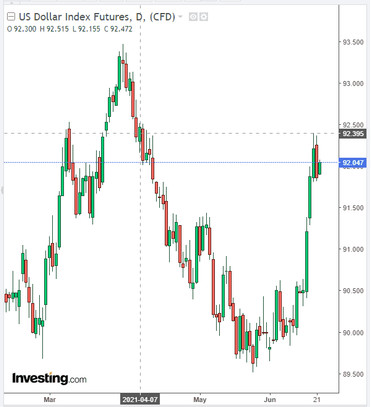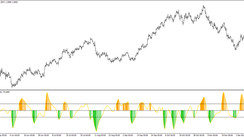Last week, the American stock market experienced a rather sharp correction and sales after the Fed meeting ended on Wednesday. Fears about the possibility of an earlier-than-expected increase in interest rates and a tightening of the Fed's position contributed to the strengthening of negative investor sentiment.
As you know, the leaders of the Federal Reserve System last Wednesday kept key interest rates in the range of 0.00% -0.25%, and the volume of the QE asset purchase program at the level of $ 120 billion per month. The accompanying statement said that the Fed will continue to adhere to the current parameters of monetary policy until the target levels for inflation and maximum employment are reached, and the level of interest rates will not change. However, some changes in the sentiments of the Fed leaders regarding the timing of the possible start of curtailing the extra soft stimulus policy of the central bank alarmed market participants. The Fed is now forecasting two rate hikes in 2023, while earlier central bank officials had pledged not to raise rates until the end of 2023. 13 of the 18 central bankers said they expect short-term interest rates to rise by the end of 2023, compared with just 7 of them in March. 7 representatives of the FOMC against 4 in March expect the start of rate hikes in 2022.
Nonetheless, investor sentiment improved yesterday, with major US stocks rallying, recovering by about half last week's losses. Thus, the industrial DJIA gained almost 720 points on Monday, which was its best result since March.
The S&P 500 Broad Market Index rose 1.72% yesterday, gaining 71 points to climb to 4228.0. At the start of today's European session, S&P 500 futures are traded near 4219.0 mark, staying above the important short-term support levels 4217.0, 4193.0 (see Technical Analysis and Trading Recommendations) and maintaining long-term positive momentum.
Fed chief Jerome Powell said Monday that job growth should pick up in the coming months. In his opinion, the recently increased inflationary pressure will ease against the background of further economic recovery from the consequences of the pandemic. This, in turn, will reduce the need for monetary tightening by the central bank.
Investors will be watching Powell's speech to the US Congress today. He will address the subcommittee on the coronavirus crisis and discuss the Fed's measures to support the economy since the beginning of the pandemic. Most likely, he will also touch on the topic of monetary policy of the Central Bank and note the progress in the field of vaccination. "There is a steady improvement in the economy", said in Powell statement prepared for today's speech to Congress.
Meanwhile, the further strengthening of the dollar, observed last week, slowed down, which was also facilitated by yesterday's statements by Powell.

As of this writing, the DXY dollar index is near 92.05 mark, 35 points below last week's high. On Friday, it hit a two-month high at 92.40 mark. The yield on 10-year Treasury bonds is at 1.497%, steadily declining from the level of more than 2 months ago near 1.753%.

This decline in long-term bond yields in the short term will hold back the dollar's rally.
Now investors are awaiting additional comments from representatives of the US Federal Reserve, which would confirm the proposed course for a smooth tightening of monetary policy. If these comments can convince investors of the opposite and the commitment of the Fed leaders not to raise the interest rate until the end of 2023, as they promised earlier, then the dollar decline may resume, and the growth in the American stock market may continue.
In conclusion, we also note that Powell's speech to Congress is scheduled to begin at 18:00 (GMT), and at this time we should expect an increase in volatility in financial markets, primarily in dollar quotes and in the American stock market.





